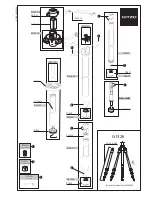
41
projector's control or remote control.
Primary Colors
Colors usually three, which are combined to produce the full range of
other colors within the limits of a system. All non-primary colors are mixtures of two or
more of the primary colors. In television, the primary colors are specific sets of red, green,
and blue.
Progressive scan
Computer images are all progressively scanned. Now, we are using
this type of scanning for HDTV. Instead of having two fields and interlacing them together
to form a frame or an image, we show each frame of a video image completely, from top
to bottom, not interlaced.
Q
R
RCA jacks
RCA connections for RCA cables, carrying line-level audio signals and some-
times video signals.
Resolution
(A) A measure of the ability of a camera or television system to reproduce de-
tail. That is the number of picture elements that can be reproduced with good definition. It
is a factor of the pickup device or the TV CRT characteristics and the signal bandwidth.
(B) Generally called horizontal
resolution. It can be evaluated by establishing the limit to which lines can be distinguished
on a test pattern. A larger resolution value means a broader frequency band of the video
signal. (C) A measure of the greatest amount of detail that can be seen, or resolved, in an
image. Often incorrectly expresses as a number of pixels on a given line. More correct is
the bandwidth.
RGB, RGB Format, RGB System
Red, Green, and Blue: The basic parallel component
set in which a signal is used for each primary color; or the related equipment or intercon-
nect formats or standards. The same signals may also be call "GBR" as a reminder of the
mechanical sequence of connections in the SMPTE interconnect standard.
S
SW
- Switch
S-VIDEO -
The generic name for Y/C video, applied to S-VHS or Beta ED
Sampling
A process in which an analog signal is converted into a series of digital values.
Saturation
The quantity of chrominance information present, (for example, the difference
between red and pink is that red is more saturated than pink.)
Set Up
- A reference to the black level in the videotape signal, also known as pedestal.
Signal
A variation in an electrical current that represents either an audio signal or a video
signal.
Signal-to-Noise Ratio (S/N)
- An S/N ratio can be given for the luminance signal, chromi-
nance signal; and audio signal. The S/N ratio is the ratio of noise to actual total signal, and
it shows how much higher the signal level is than the level of noise. It is expressed in deci-
bels (dB), and the bigger the value is, the more crisp and clear the picture and sound will
be during playback.
Sub carrier
Also SC, 3.58, 3.58CW - This is the basic signal in all NTSC sync signals. It is
a continuous sine wave, usually generated and distributed at 2 volts in amplitude, and has
a frequency of 3.579545MHz. Sub carrier is usually divided down from a primary crystal
running at 4.318180MHz, and that divided by 4 is 3.579545. All other synchronizing sig-
nals are directly divided down from
sub carrier.
Sync
Also Composite Sync - This signal is derived from a composite or combination of
horizontal and vertical drives, with some slightly narrowed and delayed pulses as well as
the addition of equalizing pulses. It is one of the more popular signals used in video


































